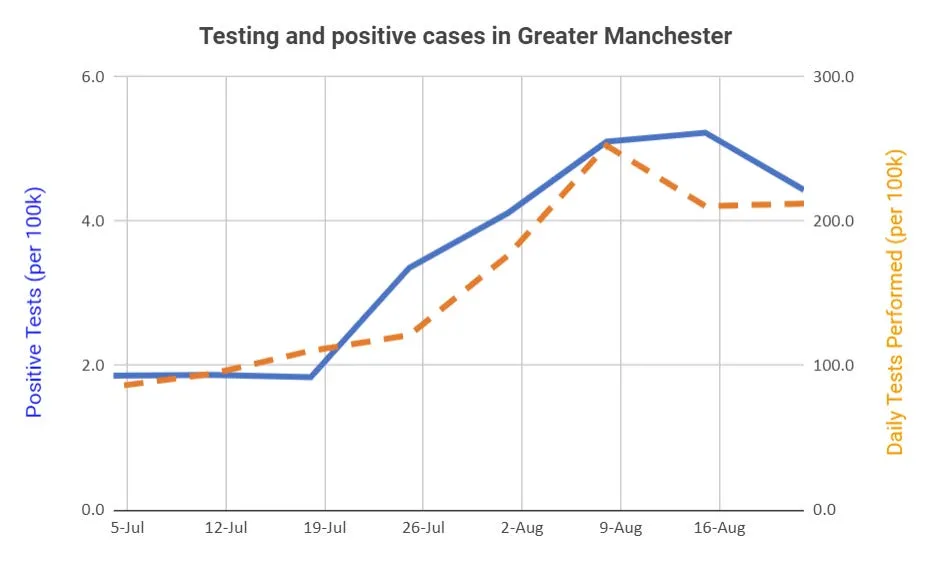Good afternoon readers, and especially those in Bolton and Trafford who woke up this morning thinking they were no longer living under extra lockdown restrictions but are currently discovering that they are in fact still covered by those rules. The government announced that U-turn about 20 minutes ago. It means only Stockport is joining Wigan in re-aligning with the rest of the country today, meaning residents can once again visit each other in their homes and gardens. The other eight boroughs of Greater Manchester are still restricted, and Oldham has some extra rules of its own.
Why the U-turn on Bolton and Trafford? Because infection rates have actually been rising in Bolton and Trafford in the past few days, and both councils asked the government to keep the restrictions in place. Bolton in particular has seen its rate spike very sharply and now has the highest infection rate in Greater Manchester, and one of the highest in the country.
As squabbling erupts between local and national government, it’s worth thinking about what infection rates actually tell us, and what we learn when we compare them to the number of tests being done. That’s the theme of today’s newsletter, which is based on a set of testing numbers released to The Mill by the Greater Manchester Combined Authority for the first time.
If you think someone you know might find this newsletter useful, please forward it to them or use the share button below
Last night Andy Burnham and the Combined Authority asked the government for an “exit strategy” from the local restrictions and called for “highly-targeted test and tracing interventions in communities most affected.”
Bolton’s infection rate is now just under 60, having been around 20 this time last week, while Oldham’s rate is in the mid 50s and Rochdale’s is in the mid 40s. The infection rate is the number of new cases detected in the past week per 100,000 residents, and it’s the main number everyone has been using to track the local outbreak. Burnham’s team releases a table of infection rates every week. But has the scale of Greater Manchester’s outbreak been overstated because of a massive increase in testing across the city-region?
At last week’s press conference I asked Burnham if he could release full testing numbers going back before this local outbreak started, and the “positivity rate” of those tests - the percentage of them coming back positive. We’re still waiting to see the positivity numbers, but his press team have sent me the testing numbers going back to early July. The numbers only cover the so-called Pillar 2 tests, which are those done in the community and don’t include testing done in hospitals, but Pillar 2 represents the large majority of testing at this point.
What they show is very significant increases in testing across Greater Manchester this summer, rising from 597 tests per 100,000 residents in the first week of July to 1765 tests per 100,000 residents in the first week of August. Since then they have fallen slightly, mainly because Rochdale has reduced its testing from a very high peak earlier in the month. (If you click on the table it should take you to a larger version).

Regular readers will know that The Mill requested these numbers from all the councils about a month ago, and most didn’t send them. The reason they matter is pretty obvious: if you don’t know how many tests are being done, it’s very difficult to make sense of the infection rates, because the more tests you do, the more cases you are likely to find. In a past newsletter I compared looking at infection rates without knowing testing numbers to looking at the Premier League table without the Games Played column.
Nationally, testing numbers have been released for some time. That’s given journalists and the public some important context for understanding what is going on. Looking at that national testing data, the BBC’s Medical Editor Fergus Walsh wrote recently: “True, confirmed coronavirus cases have been rising for a couple of months, but this can be largely explained by increases in testing.”
So, can we say the same about Greater Manchester’s outbreak? And does that explain why the sky-rocketing infection rates in our boroughs and other parts of the North West don’t seem to have led to any significant increases in hospital admissions with Covid-19 or deaths linked to the virus - both of which are still very low.
What the testing numbers show
We can now see that testing in the community more than doubled from the start of July to the end, as did the infection rate. The Greater Manchester infection rate in the final week of the month was 2.2 times higher, and testing was 2 times higher. If you plot the rising infection rate against the rise in the number of tests being done, they track each other very closely. In the graph below, the blue line is new cases and the yellow dotted line is tests performed (the new cases rate is per day on a rolling average rather than per week).

Data from Public Health England shows that in the third week of July (ending on the 25th), there was a notable uptick in the Greater Manchester infection rate - it jumped from 12.87 the week before to 28.76, an 80 per cent leap. That’s when alarm bells started sounding, and the government imposed the extra lockdown restrictions.
What these new testing numbers show is that after the initial spike in the third week of July, testing started to grow much faster than the infection rate. From the third week of July to the last, testing grew 45 per cent, but the infection rate grew only 22 per cent. In the week after that - the first week of August - testing grew 43 per cent, but the infection rate only grew 24 per cent.
Is it possible that after an initial spike in infection rates in Greater Manchester, that ramped-up testing was driving what looked like dramatic increases in the infection rate? Or to put it another way: was the actual amount of the virus in our neighbourhoods actually growing as fast as we thought it was, or were we just finding more of it because we were testing much, much more than we were at the start of July?
A spokesman for the Greater Manchester Combined Authority says that while “we would naturally expect to increase the number of cases we find” as they do more testing, there are “nuances to this.” I’ve pasted their full statement at the end of the story.
What drove the jump in testing?
How much of the increase in infection rates can be attributed to increased testing, and how much reflects actual increases in the prevalence of the disease? We can now make a much more educated guess about that, because we have the testing numbers. Different Mill readers will make different guesses based on what they have seen around them. But it’s still a guess - because we don’t know why so many more people were getting tested.
If lots more people were going to get tested because lots more people had symptoms and or knew someone who did, that might show the virus was spreading faster in their community than it was in June. But if lots more people were getting tested because the councils laid on more testing capacity (which they did), and advertised the testing sites more aggressively (which they did), then it could be that a big part of the increased rates were showing the success of the authorities in getting more people - and in particular young people - to engage with the testing programme.
What we can confidently say is that throughout this period in which infection rates have risen significantly, something like 98 people out of 100 who have gone to get tested in Greater Manchester have received a negative result. That has moved around a bit (and clearly it was higher in places like Oldham and Rochdale in certain weeks), but not much. We will have to wait for the authorities to release the official positivity rates (including the Pillar 1 tests), but from these figures it looks like at no point did any borough record the kind of positivity rates we saw in Leicester (well over 10 per cent).
I hope this new data helps Mill readers to understand the local outbreak better by adding a bit more context to what we had before. If you have any follow-up questions, please post them in the comments or reply to this newsletter, and either me or another reader will try to answer them.
Here’s the full statement from The Greater Manchester Combined Authority:
Coronavirus remains a threat in Greater Manchester. Everyone needs to remain vigilant in stopping the spread of the virus. A robust approach to testing is an important part of this vigilance. And as we increase the number of tests in this situation, we would naturally expect to increase the number of cases we find. There are however nuances to this. Testing is undertaken in a range of situations, both to directly contain the outbreak and as a more precautionary approach. The proportion of positive cases can vary. The numbers therefore should not be looked at in isolation. It is important to work across the local public health system to understand the qualitative intelligence that sits behind the tests. Interpretation of this data confirms the need for ongoing vigilance, and that the risks are not being overstated but proactively managed.
Correction: This story has been amended to remove the claim that Andy Burnham will now announce the positivity rate every week. That was based on a mis-understanding. Positivity rates are calculated by Public Health England and shared with councils. Public Health England says it’s up to the councils to release them. And Burnham’s press team says: “We don’t have positivity rates to provide you yet as they’re not our figures to share externally and would require agreement from all the data holders.” I’ll try to get you those positivity rates soon.
If you were forwarded this newsletter, join The Mill’s email list to get thoughtful and fact-based journalism about Manchester and the North West in your email inbox.

Comments
How to comment:
If you are already a member,
click here to sign in
and leave a comment.
If you aren’t a member,
sign up here
to be able to leave a comment.
To add your photo, click here to create a profile on Gravatar.






